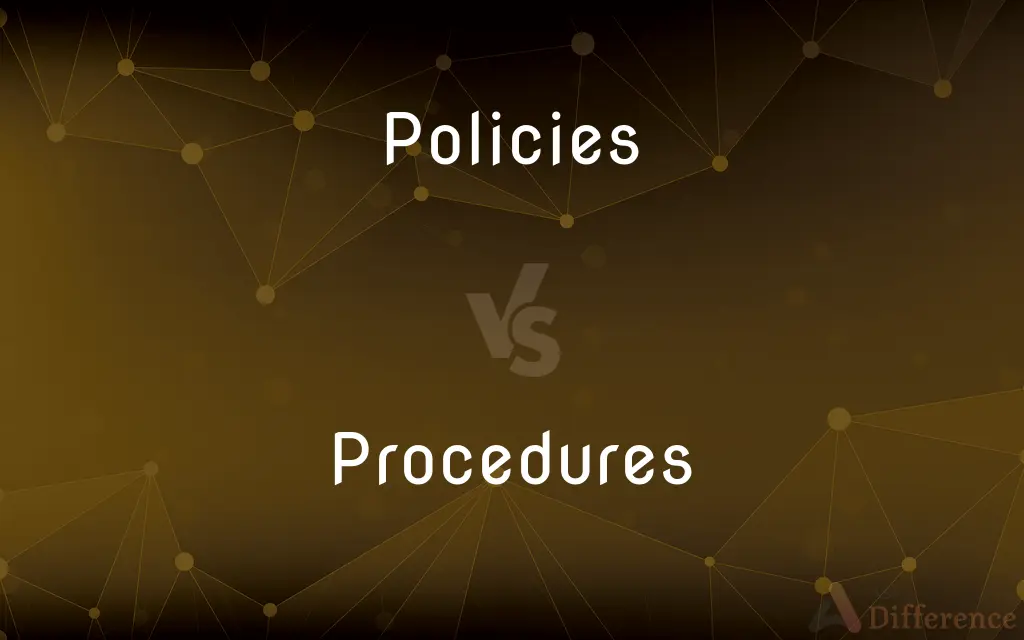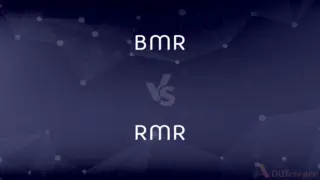Policies vs. Procedures — What's the Difference?
Edited by Tayyaba Rehman — By Fiza Rafique — Published on November 11, 2023
Policies are guidelines or rules that influence decisions, while procedures are step-by-step instructions on how to perform a specific task.

Difference Between Policies and Procedures
Table of Contents
ADVERTISEMENT
Key Differences
Policies generally refer to a set of rules or guidelines, established to make sure that a group or organization runs smoothly and effectively. Procedures, on the other hand, delve into the specifics by providing a step-by-step guide on how to implement these policies, ensuring that organizational activities are executed in a consistent and controlled manner.
Policies in a business context might include general rules about adherence to legal regulations, employee conduct, and governance of company resources. Whereas, procedures typically elaborate on these by outlining specific processes such as how to request leave, how to comply with safety standards, or how a particular job function should be executed to adhere to the stated policies.
Policies can often be wide-ranging and applicable to a broad spectrum of scenarios within an organization, providing a macro-level direction and framework. Procedures, by contrast, tend to focus on the micro-level aspects of organizational functioning, elucidating the exact sequence of steps that need to be taken to comply with a certain policy, thereby ensuring coherence and uniformity in operational activities.
Policies serve as a compass that navigates employees through the organizational journey, pointing them in the direction that the company wishes to head. Procedures act like a detailed map, guiding them through the specific path they need to take in order to reach a destination in accordance with the predetermined policies.
Comparison Chart
Definition
Guidelines or rules to steer decisions and actions.
Detailed steps on how to execute tasks and policies.
ADVERTISEMENT
Focus
What needs to be achieved or adhered to.
How specific tasks and objectives are achieved.
Flexibility
Tend to be more general and flexible.
Are usually more specific and rigid.
Purpose
Define the what and why of objectives.
Define the how-to aspect of implementing tasks.
Level of Detail
High-level, general direction.
Detailed, often sequential, instructions.
Compare with Definitions
Policies
A course or principle of action adopted or proposed by an organization.
The government’s economic policies were criticized by the opposition.
Procedures
A sequence of steps designed for handling a specific situation.
Emergency procedures were enacted during the incident.
Policies
Rules that guide or influence thought, decisions, or actions.
The store has very strict return policies.
Procedures
A series of actions conducted in a certain order or manner.
The evacuation procedures were followed during the drill.
Policies
A set of fundamental principles or established precedents.
The company’s policies on workplace behavior ensure a harmonious environment.
Procedures
A fixed, step-by-step plan for accomplishing a task or solving a problem.
The company introduced new procedures for data backup.
Policies
A strategy or plan of action designed to achieve a major aim.
The university's policies ensure equal opportunities for all students.
Procedures
The prescribed way of undertaking a process or part of a process.
Laboratory procedures must be adhered to avoid contamination.
Policies
A document outlining what a company chooses to do or not to do.
The HR policies were updated to reflect the new working conditions.
Procedures
Established methods of accomplishing a task, often detailed and systematic.
Follow the procedures outlined in the manual for assembly.
Policies
A plan or course of action, as of a government, political party, or business, intended to influence and determine decisions, actions, and other matters
American foreign policy.
The company's personnel policy.
Procedures
A manner of proceeding; a way of performing or effecting something
Standard procedure.
Policies
A course of action, guiding principle, or procedure considered expedient, prudent, or advantageous
Honesty is the best policy.
Procedures
A series of steps taken to accomplish an end
A medical procedure.
Evacuation procedures.
Policies
Prudence, shrewdness, or sagacity in practical matters
It is never good policy to speak rashly.
Procedures
(Computers) A set of instructions that performs a specific task; a subroutine or function.
Policies
A written contract or certificate of insurance.
Procedures
A set of established forms or methods for conducting the affairs of an organized body such as a business, club, or government.
Policies
A numbers game.
Procedures
(Law) The set of rules under which litigation is conducted, especially in contrast to the set of substantive legal principles that determine the merits of legal controversies and disputes.
Policies
Plural of policy
Procedures
Plural of procedure
Common Curiosities
Why are policies crucial for an organization?
Policies ensure consistency, help in decision-making, and protect the organization legally.
Can policies and procedures be changed?
Yes, they can be amended as per changing organizational needs, legal updates, or strategic shifts.
How are procedures commonly documented?
They are often documented in manuals or guides, providing clear, step-by-step instructions.
Why are procedures important to follow?
Procedures ensure tasks are performed accurately, consistently, and safely.
What is the primary purpose of policies?
To establish guidelines and standards for organizational decision-making and behavior.
Can policies be too rigid?
Yes, excessively strict policies can stifle innovation and adaptability.
How often should policies be reviewed?
Regularly, to ensure they remain relevant and compliant with current laws and standards.
How are new employees typically made aware of procedures?
Through orientation, training sessions, and procedure manuals.
How are policies communicated within an organization?
Through internal communications, policy handbooks, and training sessions.
How detailed should procedures be?
Sufficiently detailed to allow a task to be completed accurately and consistently.
What is a procedure manual?
A document that provides sequential instructions to perform a certain task or function.
Can procedures be skipped or modified while executing a task?
Generally, no - procedures should be followed as defined unless an exception is approved.
Who typically creates policies in an organization?
Leadership or management, often with input from various departments.
Who is responsible for enforcing policies?
Management and designated team leads or supervisors are typically responsible.
How do policies and procedures work together?
Policies provide the framework and goals, while procedures define the steps to implement them.
Share Your Discovery

Previous Comparison
BMR vs. RMR
Next Comparison
IMAX Theatre vs. Regular TheatreAuthor Spotlight
Written by
Fiza RafiqueFiza Rafique is a skilled content writer at AskDifference.com, where she meticulously refines and enhances written pieces. Drawing from her vast editorial expertise, Fiza ensures clarity, accuracy, and precision in every article. Passionate about language, she continually seeks to elevate the quality of content for readers worldwide.
Edited by
Tayyaba RehmanTayyaba Rehman is a distinguished writer, currently serving as a primary contributor to askdifference.com. As a researcher in semantics and etymology, Tayyaba's passion for the complexity of languages and their distinctions has found a perfect home on the platform. Tayyaba delves into the intricacies of language, distinguishing between commonly confused words and phrases, thereby providing clarity for readers worldwide.












































